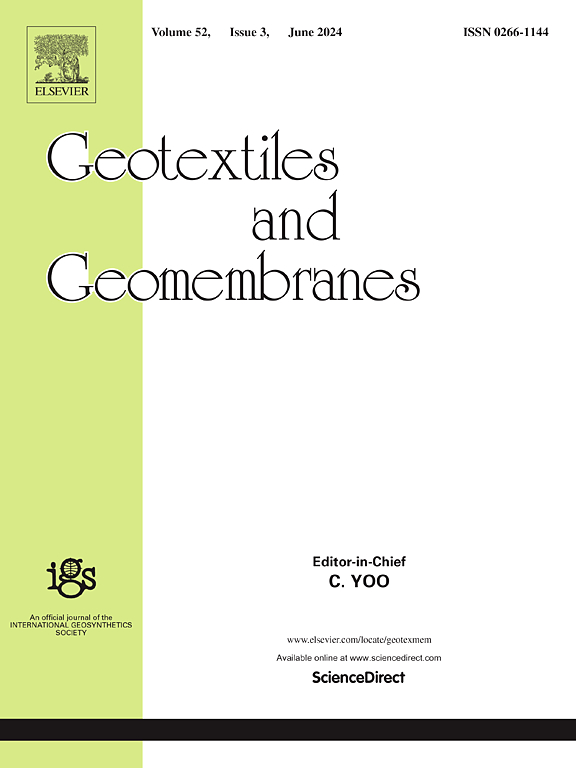Investigation on relationship of geogrid strain and settlement in the GRPS embankment under cyclic loading
IF 6.2
1区 工程技术
Q1 ENGINEERING, GEOLOGICAL
引用次数: 0
Abstract
Geosynthetic-reinforced pile-supported (GRPS) embankments provide an effective solution for mitigating subgrade settlement and enhancing service performance. This study presents a series of physical model tests aimed at gaining a comprehensive understanding of the mechanical behavior of geogrids in GRPS embankments. Effects of loading cycles, loading frequency, geogrid layer number, and pile type on geogrid strain and settlement were investigated. An empirical formula was introduced to evaluate the impact of these factors on the relationship between geogrid strain and settlement. The results demonstrate that both geogrid strain and settlement increase with loading cycles and loading frequency, while longer piles effectively reduce settlement. GRPS embankments with two geogrid layers exhibited smaller geogrid strain and settlement compared to those with a single layer. A power function incorporating the normalized geogrid strain increment ratio and settlement was developed to predict the geogrid strain variations under cyclic loading, with significant influence from the aforementioned factors. Furthermore, an application of the EBGEO method, modified to account for cyclic loadings, is proposed, which introduces a load parameter to account for the number of loading cycles. The results obtained using this modified method closely align with measured values, providing a more accurate estimation of geogrid strain development under cyclic loading.
循环荷载作用下GRPS路堤土工格栅应变与沉降关系研究
土工合成增强桩支撑(GRPS)路堤是缓解路基沉降和提高使用性能的有效解决方案。本研究提出了一系列物理模型试验,旨在全面了解GRPS路堤中土工格栅的力学行为。研究了加载周期、加载频率、土工格栅层数和桩型对土工格栅应变和沉降的影响。提出了一个经验公式来评价这些因素对土工格栅应变与沉降关系的影响。结果表明:土工格栅应变和沉降随加载周期和加载频率的增加而增加,而长桩能有效地降低沉降;与单层土工格栅相比,双层土工格栅路堤具有更小的土工格栅应变和沉降。建立了结合归一化土工格栅应变增量比和沉降的幂函数来预测循环荷载作用下土工格栅应变的变化,上述因素对土工格栅应变变化有显著影响。此外,还提出了EBGEO方法的一种应用,该方法经过修改以考虑循环荷载,该方法引入了一个荷载参数来考虑荷载循环次数。修正方法得到的结果与实测值吻合较好,能更准确地估计土工格栅在循环荷载作用下的应变发展情况。
本文章由计算机程序翻译,如有差异,请以英文原文为准。
求助全文
约1分钟内获得全文
求助全文
来源期刊

Geotextiles and Geomembranes
地学-地球科学综合
CiteScore
9.50
自引率
21.20%
发文量
111
审稿时长
59 days
期刊介绍:
The range of products and their applications has expanded rapidly over the last decade with geotextiles and geomembranes being specified world wide. This rapid growth is paralleled by a virtual explosion of technology. Current reference books and even manufacturers' sponsored publications tend to date very quickly and the need for a vehicle to bring together and discuss the growing body of technology now available has become evident.
Geotextiles and Geomembranes fills this need and provides a forum for the dissemination of information amongst research workers, designers, users and manufacturers. By providing a growing fund of information the journal increases general awareness, prompts further research and assists in the establishment of international codes and regulations.
 求助内容:
求助内容: 应助结果提醒方式:
应助结果提醒方式:


